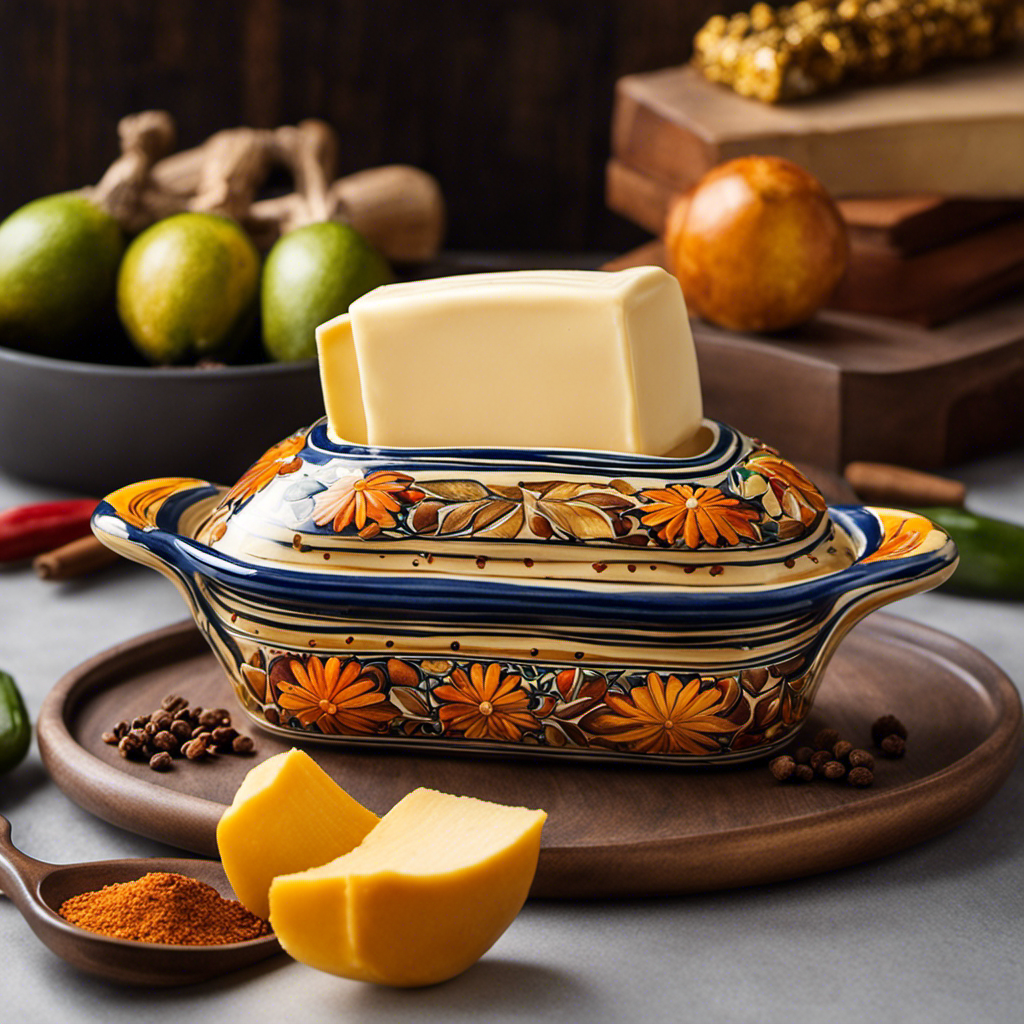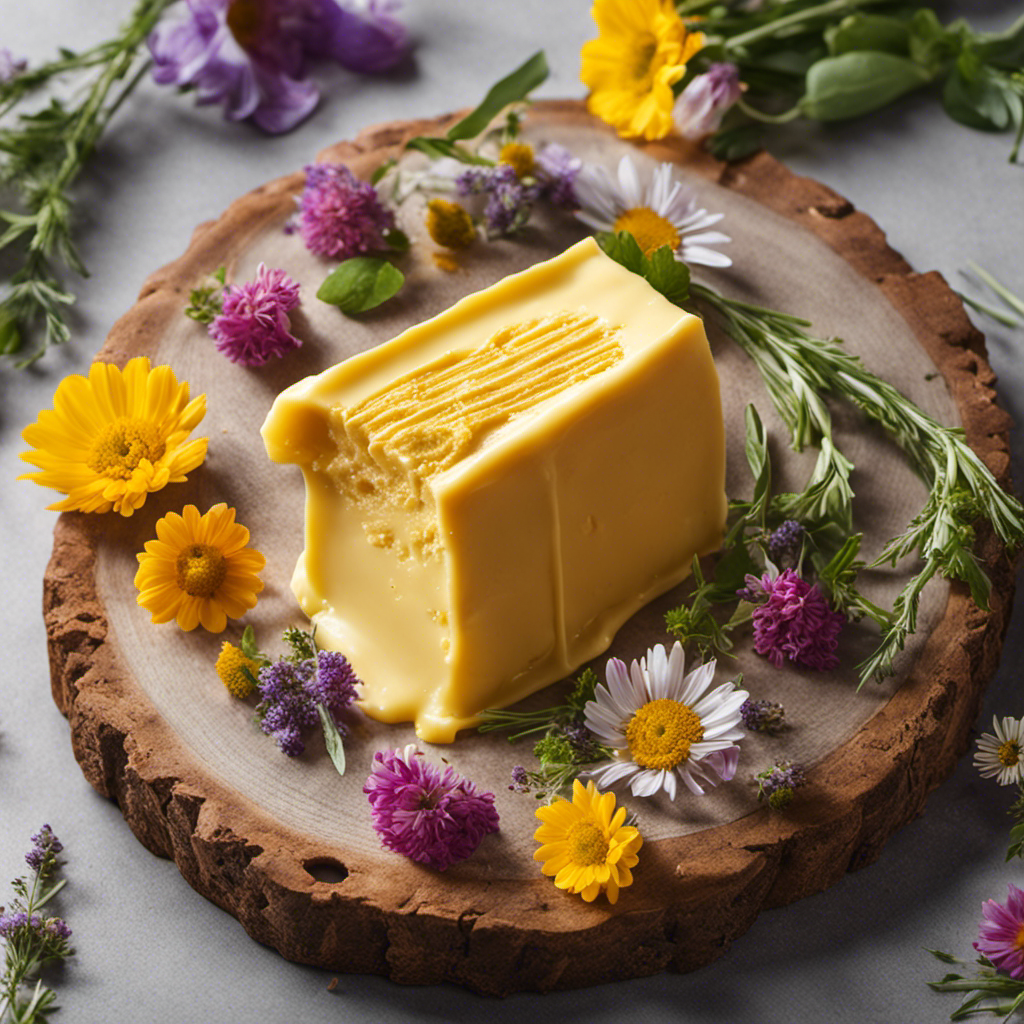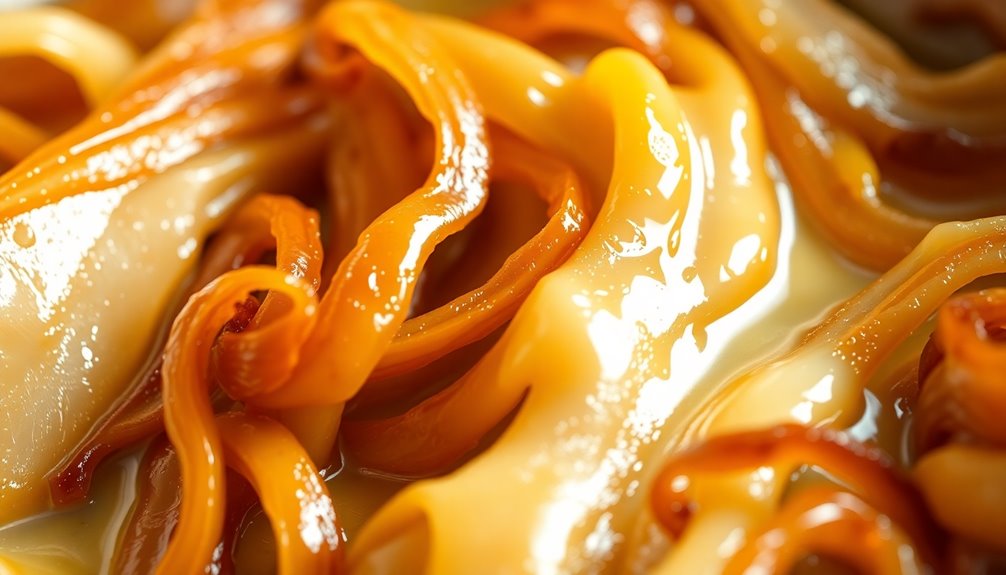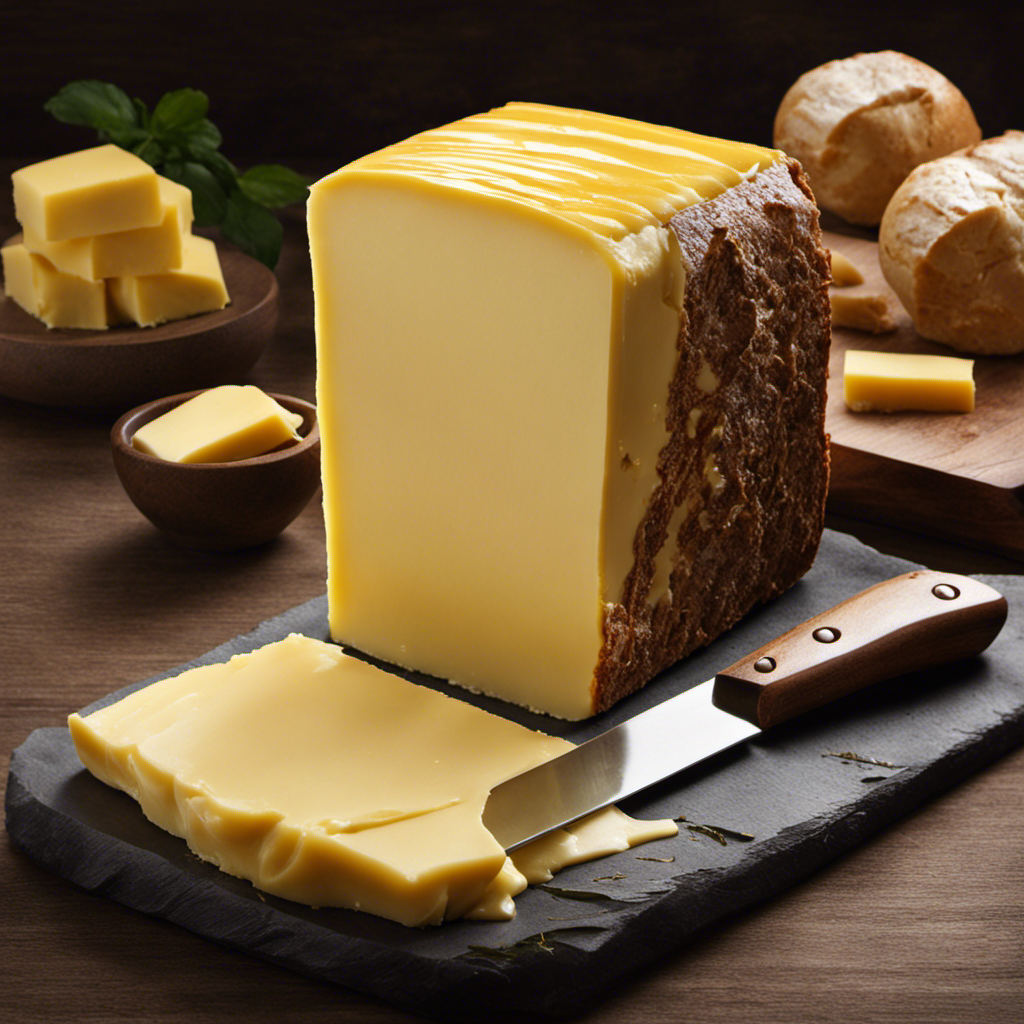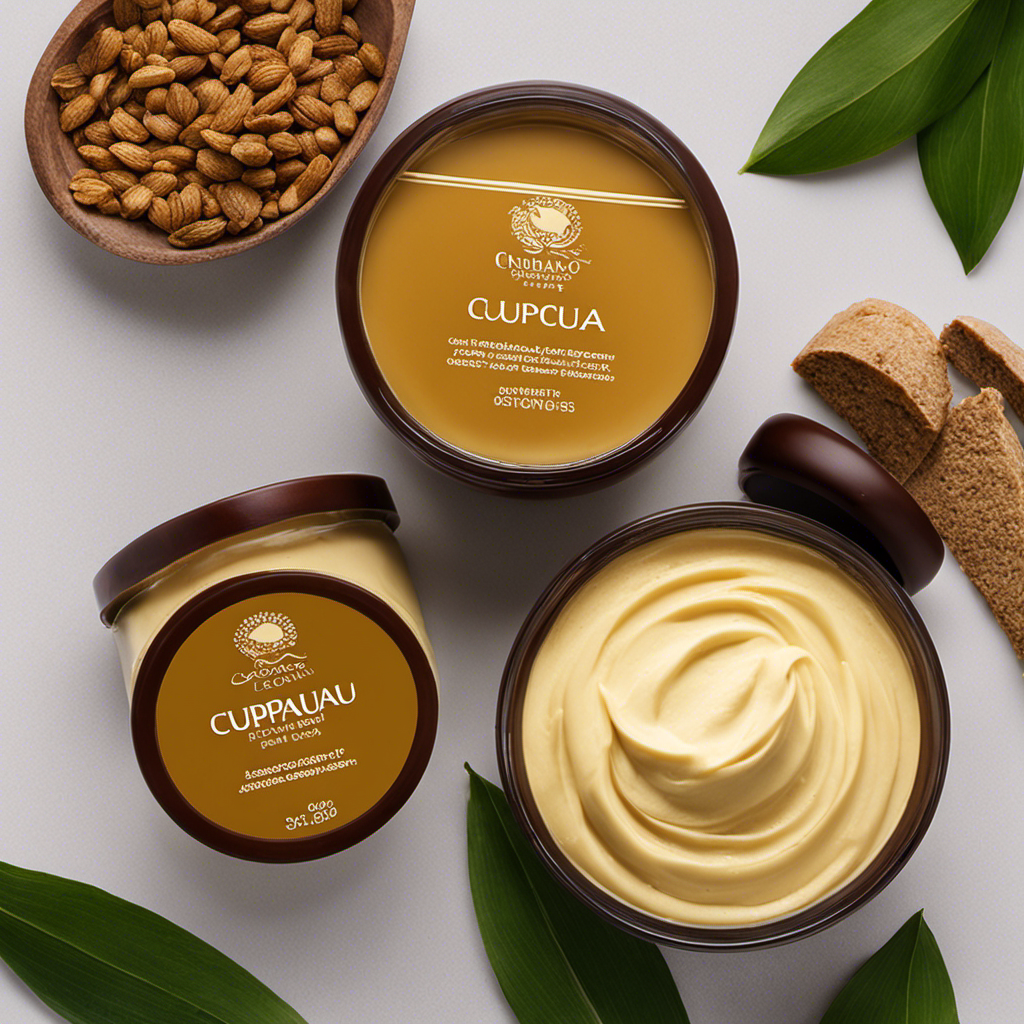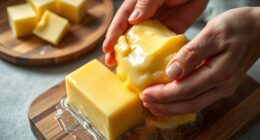Did you know that Mexican butter has a rich history and unique flavors depending on the area it comes from? It’s a fascinating topic to explore.
In this article, I will delve into the world of Mexican butter, sharing its traditional uses, how it differs from regular butter, and the health benefits it offers.
I’ll even guide you on how to make your own Mexican butter at home and provide some delicious recipes that showcase its cultural significance.
So, let’s dive in and discover the wonders of Mexican butter together!
Key Takeaways
- Mexican butter has a rich history dating back to the Mayan and Aztec civilizations and is culturally significant due to its traditional production methods.
- Mexican butter is versatile and plays a significant role in both savory and sweet Mexican dishes, adding richness and depth of flavor.
- Regional variations of Mexican butter, such as manteca, mantequilla, ghee, and cajeta, highlight the diverse culinary landscape of Mexico.
- Mexican butter has a unique taste and texture compared to regular butter, known for its rich and creamy flavor with a slightly tangy and salty undertone.
The History of Mexican Butter
The history of Mexican butter dates back centuries, with its origins rooted in the ancient Mayan and Aztec civilizations. Dairy farming in Mexico has a rich history that has been passed down through generations.
The Mayans and Aztecs were skilled farmers who understood the importance of dairy products in their diet. They mastered the art of raising cows and goats, and used their milk to produce butter. The process of making butter was not only a practical way to preserve the milk, but also a cultural tradition. Butter was used in various rituals and ceremonies, symbolizing abundance and fertility.
These cultural traditions and rituals laid the foundation for the importance of Mexican butter in the country’s culinary heritage. Transitioning into the next section, let’s explore the traditional uses of Mexican butter.
Traditional Uses of Mexican Butter
Explore the rich culinary heritage of Mexico and discover how locals incorporate this flavorful ingredient into their traditional recipes. Mexican butter is a staple in many traditional Mexican dishes, adding a rich and creamy texture, as well as a distinct flavor. Here are four ways Mexican butter is used in cultural traditions:
-
Enchiladas: Mexican butter is often used to sauté the tortillas before filling them with various ingredients like cheese, meat, or vegetables. This adds a delicious and buttery taste to the dish.
-
Tamales: Mexican butter is an essential ingredient in making the masa dough for tamales. It adds moisture and richness to the dough, resulting in tender and flavorful tamales.
-
Salsas: Mexican butter can be melted and used as a base for salsas, adding a smooth and velvety texture to the sauce. It helps balance out the spiciness and enhances the overall flavor.
-
Pastries: Mexican butter is commonly used in traditional Mexican pastries like conchas and pan dulce. It gives the pastries a buttery and slightly sweet taste, making them irresistible.
Incorporating Mexican butter into traditional recipes is an important part of preserving cultural traditions and ensuring the authentic flavors of Mexican cuisine.
How Mexican Butter Differs From Regular Butter
Mexican butter offers a unique taste and texture compared to regular butter. It is known for its rich and creamy flavor, with a slightly tangy and salty undertone. The texture is also distinct, being smooth and spreadable at room temperature.
In Mexican cuisine, butter plays a significant role in both savory and sweet dishes, adding richness and depth of flavor. From using it in traditional recipes like mole to spreading it on warm tortillas, Mexican butter is a staple ingredient that showcases the cultural significance and versatility of this dairy product.
Taste and Texture Differences
There’s definitely a noticeable difference in taste and texture when it comes to Mexican butter. Mexican butter is known for its distinct flavor profile and rich, creamy texture that sets it apart from regular butter. Here are four reasons why Mexican butter stands out:
-
Taste Preferences: Mexican butter is often made from the milk of cows that graze on lush pastures, resulting in a unique flavor that is both slightly sweet and tangy. This flavor adds depth and complexity to dishes.
-
Cooking Techniques: Mexican cuisine relies heavily on butter as a key ingredient in many traditional dishes. The unique taste and texture of Mexican butter enhance the flavors and consistency of these dishes, making them truly authentic.
-
Quality Ingredients: Mexican butter is often made from high-quality, locally sourced ingredients. This attention to detail in sourcing ensures a superior product that delivers exceptional taste.
-
Traditional Production Methods: Mexican butter is often made using traditional production methods, such as churning the cream by hand. These methods contribute to the unique texture and flavor that sets Mexican butter apart.
With its distinctive taste and texture, Mexican butter plays a significant role in the culinary traditions of Mexico. From enriching sauces to bringing out the flavors of traditional dishes, Mexican butter is an essential ingredient in Mexican cuisine.
Cultural Significance and Uses
One of the reasons why Mexican butter is so culturally significant is because of its traditional production methods. Mexican butter is made using ancient techniques that have been passed down through generations. This careful and time-honored process creates a rich and flavorful product that is unique to Mexico.
Mexican butter is known for its distinct taste, which can vary depending on the region and the breed of cows used. It has a creamy texture and a slightly tangy flavor that sets it apart from other types of butter. This unique flavor profile makes it a beloved ingredient in Mexican cuisine, where it is used in a variety of dishes, from savory sauces to sweet pastries.
The cultural traditions surrounding Mexican butter highlight the importance of preserving and celebrating traditional methods of food production.
Regional Variations of Mexican Butter
You might be surprised by the different variations of butter found in different regions of Mexico. Each region has its own unique take on this dairy product, reflecting the diverse culinary traditions and cultural significance of the area.
Here are four regional variations of Mexican butter that showcase the country’s rich gastronomic heritage:
-
Manteca: Commonly used in northern Mexico, manteca is rendered pork fat that is often flavored with spices like garlic and onion. It adds a rich, savory taste to dishes like beans and tamales.
-
Mantequilla: This is the most common type of butter found in Mexico. It is made from cow’s milk and has a creamy, smooth texture. Mantequilla is used in a wide range of dishes, from traditional Mexican sauces to baked goods.
-
Ghee: Originating from the Yucatan Peninsula, ghee is clarified butter that has been simmered to remove any impurities. It is commonly used in traditional Mayan cooking and adds a nutty, aromatic flavor to dishes.
-
Cajeta: Hailing from the central region of Mexico, cajeta is a thick, caramel-like spread made from goat’s milk. It is often used as a topping for desserts like flan or as a filling for pastries.
These regional variations of Mexican butter highlight the diverse culinary landscape of Mexico and the cultural significance of butter in different regions.
Health Benefits of Mexican Butter
I have done extensive research on the nutritional value of Mexican butter and its impact on heart health, and I can confidently say that it offers numerous health benefits.
Mexican butter is rich in essential nutrients like vitamins A, D, and E, as well as omega-3 fatty acids, which are known to support heart health.
Consuming Mexican butter in moderation can contribute to a well-rounded and heart-healthy diet.
Nutritional Value of Mexican Butter
The nutritional value of Mexican butter is not as high as some other dairy products. However, it still offers certain nutritional benefits. Here are four key points to consider:
-
Lower in fat: Mexican butter typically has a lower fat content compared to other types of butter. This makes it a good option for those who are watching their fat intake.
-
Rich in flavor: While the nutritional value may not be as high, Mexican butter is known for its rich and flavorful taste. It can enhance the flavor of dishes and add a creamy texture.
-
Versatile cooking techniques: Mexican butter can be used in various cooking techniques, such as sautéing, frying, or baking. Its high smoke point makes it suitable for high-heat cooking methods.
-
Source of vitamins: Although in smaller amounts, Mexican butter still provides some essential vitamins like vitamin A and vitamin D, which are important for overall health.
While Mexican butter may not be the most nutritious option, it can still be enjoyed in moderation and used to enhance the flavors of your favorite dishes.
Impact on Heart Health
Lower in fat, Mexican butter still offers certain nutritional benefits and can be enjoyed in moderation to enhance the flavors of your favorite dishes. When it comes to heart health, it’s important to consider the impact of saturated fat on cholesterol levels and the relationship between saturated fat and heart disease.
While Mexican butter may contain some saturated fat, it is important to remember that moderation is key. Consuming excessive amounts of saturated fat can raise cholesterol levels, which may increase the risk of heart disease. However, when enjoyed in moderation as part of a balanced diet, Mexican butter can still be a flavorful addition to your meals.
In the subsequent section, I will explain how to make Mexican butter at home, so you can enjoy its rich taste while controlling the ingredients.
How to Make Mexican Butter at Home
To make Mexican butter at home, you’ll need a few simple ingredients and a blender. Here’s a step-by-step guide to help you recreate the delicious flavor of Mexican butter in your own kitchen:
-
Ingredients:
- 1 cup unsalted butter, softened
- 2 tablespoons lime juice
- 1 teaspoon chili powder
- 1/2 teaspoon salt
-
In a blender, combine the softened butter, lime juice, chili powder, and salt. Blend until well mixed and smooth.
-
Once blended, transfer the mixture into a small bowl or container.
-
Store the Mexican butter in the refrigerator for up to two weeks. It’s best to use an airtight container or wrap it tightly in plastic wrap to prevent any odors from permeating the butter.
When it comes to the best Mexican butter brands, some popular options include Lurpak and Kerrygold. These brands are known for their high-quality butter and rich, creamy flavor that complements Mexican dishes perfectly.
Popular Mexican Recipes Using Butter
When making popular Mexican recipes, it’s important to have a good quality butter that adds richness and enhances the flavors. Mexican butter is known for its unique taste and texture, which can elevate any dish to new heights.
One of the most popular Mexican desserts that require butter is the tres leches cake. This moist and decadent cake is made with three types of milk and topped with whipped cream, creating a heavenly treat that is loved by many.
Additionally, Mexican butter can be used in other alternative ways, such as spreading it on warm corn tortillas or using it to sauté vegetables for dishes like enchiladas or fajitas. Its rich flavor and creamy consistency make it a versatile ingredient that can be incorporated into various Mexican dishes, both sweet and savory.
Exploring the Cultural Significance of Mexican Butter
You’ll be fascinated by the cultural significance of this unique ingredient in Mexico. Mexican butter plays a vital role in the country’s culinary traditions and is deeply intertwined with its cultural identity.
Here are four ways Mexican butter holds symbolic meaning and is celebrated in traditional events:
-
Symbol of Abundance: Mexican butter is often used in festive dishes during celebrations like weddings and quinceañeras, symbolizing prosperity and abundance.
-
Cultural Heritage: The making of Mexican butter has been passed down through generations, preserving the country’s culinary heritage and connecting people to their roots.
-
Ritual Offerings: In religious festivals, Mexican butter is sometimes used as an offering to deities, representing devotion and gratitude.
-
Flavor Enhancer: Mexican butter adds a rich and creamy taste to traditional dishes like tamales and pan dulce, enhancing their flavors and making them even more delicious.
Mexican butter not only adds flavor to meals but also serves as a symbol of cultural identity and tradition in Mexico’s vibrant culinary landscape.
Where to Buy Authentic Mexican Butter
For an authentic taste of Mexico, check out local markets and specialty stores that carry traditional ingredients like this. When it comes to finding authentic Mexican butter, there are a few options to consider.
One popular brand is Lurpak, which is known for its rich and creamy texture. You can find Lurpak butter at most major supermarkets and online retailers.
Another brand to look for is President, which offers a range of Mexican butter flavors such as garlic and herb. President butter can be found at specialty food stores and gourmet shops.
If you prefer a more traditional option, seek out local Mexican grocers or farmers markets. These places often carry homemade or artisanal Mexican butter, made from local ingredients and traditional recipes.
Frequently Asked Questions
Can Mexican Butter Be Used as a Substitute for Regular Butter in Baking?
Yes, Mexican butter can be used as a substitute for regular butter in baking. It adds a unique flavor profile to baked goods. However, it’s important to note that there are different types of butter used in baking, each with its own distinct characteristics.
What Is the Shelf Life of Mexican Butter?
The shelf life of Mexican butter depends on various factors such as storage requirements. It is important to store it properly in a cool, dry place to extend its shelf life and maintain its quality.
Are There Any Special Storage Requirements for Mexican Butter?
There are no special storage requirements for Mexican butter. It is not significantly different from regular butter in terms of how it should be stored. Keep it refrigerated to maintain freshness.
Is Mexican Butter Suitable for Those With Lactose Intolerance?
Mexican butter is not suitable for those with lactose intolerance due to its high lactose content. Individuals with lactose intolerance can opt for lactose-free butter alternatives or use oils like olive or coconut as substitutes.
Can Mexican Butter Be Used in Savory Dishes as Well, or Is It Primarily Used in Sweet Recipes?
Mexican butter can be used in both savory and sweet dishes. It is commonly used in traditional Mexican cuisine for its unique flavor. Compared to other types of butter, Mexican butter has a richer taste and a slightly higher fat content.
Conclusion
In conclusion, Mexican butter is a rich and flavorful ingredient that has a long history and a unique place in Mexican cuisine.
It is interesting to note that according to a recent study, Mexico is the 10th largest consumer of butter in the world. This statistic showcases the popularity and importance of butter in Mexican cooking.
Whether used in traditional recipes or as a spread on bread, Mexican butter adds a delicious touch to any dish.
So why not give it a try and experience the vibrant flavors of Mexican cuisine for yourself?
